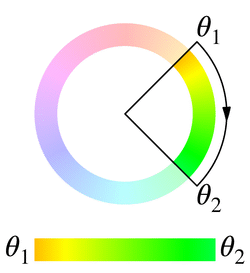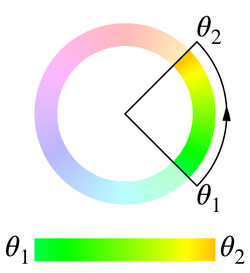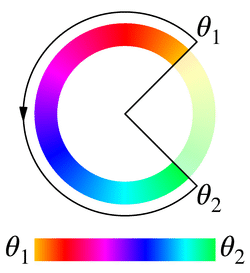<hue-interpolation-method>
Baseline 2023
Newly available
Since May 2023, this feature works across the latest devices and browser versions. This feature might not work in older devices or browsers.
CSS 数据类型 <hue-interpolation-method> 表示用于在 <hue> (en-US) 值之间插值的算法。此插值方法指定了如何根据色轮求两个色相值之间的中点。此数据类型用作数据类型 <color-interpolation-method> 的分量。
在对 <hue> 值进行插值时,色相插值算法默认为 shorter。
语法
<hue-interpolation-method> 值由色相插值算法的名称后接字面标记 hue 所构成:
shorter hue longer hue increasing hue decreasing hue
取值
任意一对色相角 θ1 和 θ2 对应色轮 (en-US)上的两条半径,且将圆周切为两段可用于插值的弧。两段弧均起于第一条半径并止于第二条半径,但一段为顺时针方向而另一段为逆时针方向。
备注: 下列描述和图示均基于色相角沿顺时针方向递增的色轮。注意在其他某些色轮中色相角递增对应逆时针操作。
有四种确定所用弧的算法:
shorter-
使用劣弧。当两条半径重合时,此弧退化为单点。当两段弧长度相等时:
- 若
θ1 < θ2,则使用顺时针弧; - 若
θ1 > θ2,则使用逆时针弧。
θ1 = 45deg、θ2 = 135degθ1 = -225deg、θ2 = 45deg

- 若
longer-
使用优弧。当两条半径重合时:
- 若
θ1 ≤ θ2,则此弧变为顺时针定向的整个圆周。 - 若
θ1 > θ2,则此弧变为逆时针定向的整个圆周。
当两段弧长度相等时:
- 若
θ1 < θ2,则使用顺时针弧。 - 若
θ1 > θ2,则使用逆时针弧。
θ1 = 45deg、θ2 = -225degθ1 = 135deg、θ2 = 45deg

- 若
increasing-
使用顺时针弧。当两条半径重合时:
- 若
θ1 < θ2,则此弧变为顺时针定向的整个圆周。 - 若
θ1 ≥ θ2,则此弧退化为单点。
θ1 = 45deg、θ2 = 135degθ1 = 495deg、θ2 = 45deg

- 若
decreasing-
使用逆时针弧。当两条半径重合时:
- 若
θ1 ≤ θ2,则此弧退化为单点。 - 若
θ1 > θ2,则此弧变为逆时针定向的整个圆周。
θ1 = 45deg、θ2 = 495degθ1 = 135deg、θ2 = 45deg

- 若
形式语法
示例
比较各种色相插值算法
下列示例展示了在 linear-gradient() 中使用不同的色相插值算法的效果。
HTML
<div class="hsl">
<p>HSL</p>
</div>
<div class="hsl-increasing">
<p>HSL increasing</p>
</div>
<div class="hsl-decreasing">
<p>HSL decreasing</p>
</div>
<div class="hsl-longer">
<p>HSL longer</p>
</div>
<div class="hsl-named">
<p>HSL 具名颜色</p>
</div>
<div class="hsl-named-longer">
<p>HSL 具名颜色(longer)</p>
</div>
CSS
.hsl {
background: linear-gradient(
to right in hsl,
hsl(39deg 100% 50%),
hsl(60deg 100% 50%)
);
}
.hsl-increasing {
background: linear-gradient(
to right in hsl increasing hue,
hsl(190deg 100% 50%),
hsl(180deg 100% 50%)
);
}
.hsl-decreasing {
background: linear-gradient(
to right in hsl decreasing hue,
hsl(39deg 100% 50%),
hsl(60deg 100% 50%)
);
}
.hsl-longer {
background: linear-gradient(
to right in hsl longer hue,
hsl(39deg 100% 50%),
hsl(60deg 100% 50%)
);
}
.hsl-named {
background: linear-gradient(to right in hsl, orange, yellow);
}
.hsl-named-longer {
background: linear-gradient(to right in hsl longer hue, orange, yellow);
}
结果
规范
| Specification |
|---|
| CSS Color Module Level 4 # hue-interpolation |
浏览器兼容性
css.types.color.color-mix
BCD tables only load in the browser
css.types.image.gradient.conic-gradient.hue_interpolation_method
BCD tables only load in the browser
css.types.image.gradient.linear-gradient.hue_interpolation_method
BCD tables only load in the browser
css.types.image.gradient.radial-gradient.hue_interpolation_method
BCD tables only load in the browser
css.types.image.gradient.repeating-conic-gradient.hue_interpolation_method
BCD tables only load in the browser
css.types.image.gradient.repeating-linear-gradient.hue_interpolation_method
BCD tables only load in the browser
css.types.image.gradient.repeating-radial-gradient.hue_interpolation_method
BCD tables only load in the browser